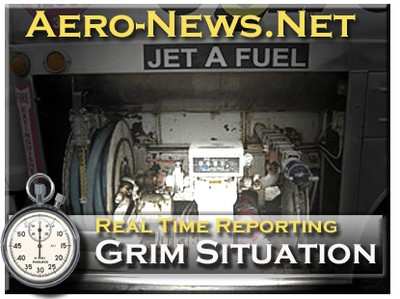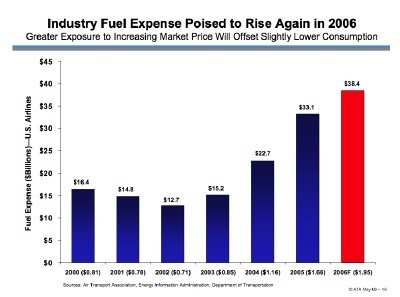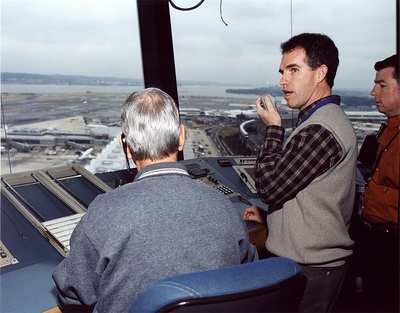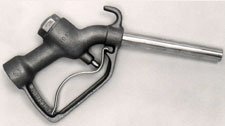Changes Would Save Time, Fuel
The Air Transport Association, the lobbying group for the major
United States Part 121 airlines (passenger and cargo), has long
been the authoritative voice of the airline industry. In the ATA's
latest briefing on the contentious fuel issue, the organization
mentions several potential ATC changes that might lead to time and
fuel savings.

The slide begins by praising the 2005 introduction of RVSM as an
example of the sort of procedural improvement that can save gas and
increase system capacity while maintaining an equivalent level of
safety. RVSM, Reduced Vertical
Separation Minimums reduces mandatory vertical separation between
flight levels 290-410 (inclusive) from 2,000 feet to 1,000 feet,
providing a theoretical doubling of traffic throughput.
Are there more potential gains to be found in the system? The
ATA thinks so.
Here's ATA's list -- with a little of ATA's expanding text, and
our comments. Due to the amount of information involved, we've
split this into two parts. Yesterday, we examined the
ATA's intent to expand the deployment of RNAV at major airports...
as well as its request the FAA reconsider the current 250-knot
"speed limit" below 10,000 feet MSL.

Today, we look at some of the ways ATA proposes to reduce delays
and holding times -- as well as offering our summary of the
situation.
The Wish List
- Provide more timely information to flight crews to increase
opportunity to avoid operating engines when departure delays are in
effect.
ANN Take: The biggest cause of departure
delays, of course, is the unrealistic scheduling of ATA member
airlines. If you have six airlines flying to six destinations every
day at six AM, you have to have either 36 runways, or delays. While
we're all in favor of information to all pilots, why shouldn't the
ATA member have to pay for the delays that they impose on other
aircraft -- not to mention, the costs that their peaky preferred
operating mode impose on the system.

We'd rather see takeoff slots at Part 139 airports auctioned.
You want to take off at 0600 on the jot? Better outbid the other
guy. The next slot is 0603.. 0606... 0609. And both the slots and
the payment should be forfeit if the line doesn't fly, to prevent
the anti-competitive practice of buying resources to strangle
competitors. And passengers might well pay more for flights at the
more attractive times, less in off-hours -- just like the good ol'
days.
Still, there's nothing wrong with warning a flight that they're
better off sitting in the gate, plugged into mains power and
ground-based AC, than cranking and sitting on a taxiway polluting
the atmosphere. A turbine burns prodigious quantities of fuel at
sea level, even idling, and we ought to work together to prevent
this waste.

ANN Take: this may work in a sky in which all
aircraft are operating on regularly scheduled flights. Increased
ability to flight-plan and fly great circle routes, for instance,
would benefit all long-range flights, but require ATC to be able to
project that route of flight and deconflict it. Our take on this is
that ATA does not want its members' airliners taken off centrally
planned minimum-fuel routes for a direct clearance -- something
that most GA operators would just as soon accept, as they're more
likely to value reduced flight time than reduced fuel burn in most
cases. Perhaps we're misunderstanding ATA here. (One ATP's take was
"they WANT to fly less efficient altitudes?").
- Coordinate "HOLDING" alerts to operational degree possible
and increase controller awareness of aircraft fuel consumption when
holding at low altitudes
ANN Take: This is a reasonable request. In our
experience, however, approach and center controllers do seem to be
quite attuned to the fine details of aircraft performance. That's
impressive when you consider the wide range of machinery they
encounter daily.
Once again, a principal cause of holding is scheduling. If
companies had to buy arrival slots -- and pay a penalty for missing
them -- holding could be greatly reduced. The ultimate problem is
that there are not enough runways in peak destinations at peak
hours.
- Allow short ground delays or user-preferred trajectories in
lieu of circuitous re-routes
 ANN Take:
Again, this needs to be staffed up and worked out on the controller
side, but this would benefit all users of the ATC system. Nobody
likes being routed all over East Overshoe whether he's driving an
Airbus, a Citation, or a Skyhawk.
ANN Take:
Again, this needs to be staffed up and worked out on the controller
side, but this would benefit all users of the ATC system. Nobody
likes being routed all over East Overshoe whether he's driving an
Airbus, a Citation, or a Skyhawk.
- Offer re-route options whenever multi-route options are
available
ANN Take: This would be great for all users,
again, including all of GA that flies in the system, but is it
practical for controllers? The controllers are limited by human
bandwidth and the problems the FAA has had rolling out upgraded
computer systems -- the computer you're reading this on is a lot
newer and arguably more powerful than the ones keeping you
separated.
ANN Summary
Many of the ATA's desires deserve broad support in the aviation
community because they benefit all users of the ATC system -- a
system that was, factually, designed for the benefit of the
airlines that ATA now represents. But others represent corporate
welfare, that would benefit the ATA's 19 US airline members
and four North American associate members, at the expense of
other users, and the public.
To be sure, we'd be much more sympathetic to the airlines'
plight if their various senior executives hadn't taken such extreme
measures to benefit themselves, at the expense of their workers,
customers and most especially stockholders. As long as that kind of
backroom dealing is de rigeur at the airlines, it's hard to have
any sympathy, beyond that we have for the ill-treated air, ground,
and office workers. (Stockholders take a risk consciously. You
could have done very well on some airlines in the last year, with
luck -- AMR for instance. You could still lose your shirt before
2006 is out if you play in this market).

It's good to get this discussion started, because there's
certainly room for reasonable people to agree on measures that save
the airlines money, benefit the environment, help or at least don't
seriously harm the other users or the ATC system, and are feasible
and practical for ATC to implement.
To get to that point, this needs to be a four-cornered (at
least) discussion with all interests represented: not just ATA, but
NBAA, AOPA, and FAA. ATA has done its homework and made its
proposals; who's next?
(The ATA slides for the briefing by VP and Chief Economist John
Heimlich, "Energy Matters: Combating the Fuel-Related Challenges
Facing U.S. Airlines," are available on the ATA website in the FMI
link. There's a lot of fuel-related information in the
well-organized brief, including an interesting overview of
fuel-conservation measures in use in the industry).
 Aero-News: Quote of the Day (04.28.25)
Aero-News: Quote of the Day (04.28.25) ANN's Daily Aero-Term (04.28.25): Decision Altitude (DA)
ANN's Daily Aero-Term (04.28.25): Decision Altitude (DA) ANN's Daily Aero-Linx (04.28.25)
ANN's Daily Aero-Linx (04.28.25) Airborne-Flight Training 04.24.25: GA Refocused, Seminole/Epic, WestJet v TFWP
Airborne-Flight Training 04.24.25: GA Refocused, Seminole/Epic, WestJet v TFWP Aero-News: Quote of the Day (04.29.25)
Aero-News: Quote of the Day (04.29.25)








